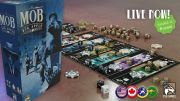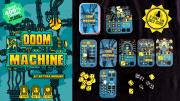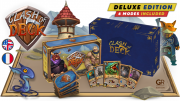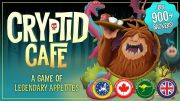Bandada (Chase Estep) – A dice manipulation game for one-to-two players. All twelve dice are rolled and arranged by color. The twelve bird cards are shuffled and three placed face up on the table, while the rest form the draw pile. The game is played over four rounds with each round split into two phases. During the drafting phase, each player selects a bird card and places it in front of themselves. You then perform the card's actions, which will have you adjusting the values of dice on the table. Next you score your new bird. Birds score based on different criteria that depend on the dice. For example, a bird might score one point for each matching color pair of dice that show the same value. During the second phase, you score points for all the birds you've collected thus far. Any birds not selected are then discarded and another three are drawn to form the display for the next round.
Casual Games on Kickstarter: From Collecting Butterflies to Running the Mob

February brings a number of solo and two player games to Kickstarter, a card game with six different game modes, a tile placement spatial puzzle, and a game of sasquatch waiters serving fabled customers.
MOB: Big Apple (TGG Games) – In this two player game, each player is head of a crime family vying for control. The game is played over three rounds. At the start of each round, both players take twenty henchmen in their player color. Each round, players alternate turns, until they have both used all twenty of their henchmen. Each turn has two phases. Phase one is optional: load henchmen into a car. You roll both dice — there is a black die and a white die and each can roll one to three. Each die result corresponds to one of the six locations on the board. You then choose one of the locations whose die result you rolled, and place a number of henchmen on that location’s car equal to the number rolled on the die you did not select. You cannot have more than three henchmen in a single car. At the end of the round henchmen at each location will fight, with equal numbers being removed from each team until one player has no henchmen remaining at that location. The second action on your turn is mandatory: select an action. You place one or more henchmen on an empty action space on the action board (different actions require you to place a different number). Actions allow you to do things such as move henchmen between cars or move a henchman from a car into a location, or place crates at locations. At the end of the game, players earn points for controlling locations where crates are present.
Doom Machine (Nathan Meunier) – In this solo game that fits inside a small tin, you are battling to defeat an evil doom machine. Doom cards are laid out on the table and each round a new one is drawn. A yellow die is assigned to each doom card with the value set to the card's health. On your turn, you roll your black dice to try to get them to the correct values as dictated by each doom card in order to inflict damage. When a doom card is destroyed, you take its yellow die and add it to your supply, increasing the number of dice you have to roll. At the end of the round, each doom card that is not destroyed performs an action such as healing or dealing you damage.
Clash of Deck (Grammes Edition) – Two bridge cards are placed in the center of the table and each player takes a watchtower card, which they place as the leftmost card in their hand. On your turn, you have three phases. During phase one, you earn as much mana as you have cards in your hand. During phase two you may spend mana to play a card from your hand. You may only play the four cards that are on the leftmost side of your hand, not counting your watchtower. You then place the card you played on your side of one of the two bridges. Next is the assault phase. Each card has a set number of health and attack value. Also a card cannot attack on the turn it was summoned. If a card is destroyed it is returned to its owner's hand in the right most spot. If there are no targets for your unit to attack, it then attacks the opponent's watchtower. When a watchtower is hit, it moves its location in its player's hand. Once it reaches the rightmost location it is destroyed and the other player wins the game. Clash of Deck includes multiple game modes: competitive, duel, 2v2, cooperative, solo, and legacy.
Factory Floor (Space Duck Games) – Each player takes a board that shows a grid of spaces. Each round, players take turns selecting an action: drafting a room tile, which they must then place on top of empty spaces on their board; hire workers, which allows you to place workers on a staff room tile you have on your board; or spend a worker, which allows you to move a room from one location on your board to another. At the end of the round players will move workers from staff rooms onto production rooms and then score points for their production rooms, earning extra for ones that have workers in them. At the end of the game, players will score any production rooms again which are adjacent to quality control rooms, and earn bonus points for things such as having the largest number of staff rooms adjacent to each other. You also will lose a point for each space on your board which is not covered with a room tile. You can read our review of Factory Floor here.
Cryptid Cafe (Squatchy Games) – During phase one of each round, players take turns placing meeples on the food station. The food station has multiple rows, each associated with a different type of food, and each row has three spaces numbered one through three. During phase two, each player who is at the one space in a row, may spend money to move up the line. Each player then receives food tokens. You earn a number of tokens of each food type based on which space your meeple is on in that food type's row. Players can then serve their customer cards by giving them the appropriate food tokens. You earn coins based on how long the customer has been waiting. If the customer is left waiting too long, they'll leave the restaurant and you will lose points.
Disclosure: unless otherwise noted, we have not seen or played any of the above games. Our assessment of each is based on the information given on the crowdfunding project page.










